Plume update: ‘PLUME: 4000 Varieties of Orange’ Raewyn Turner & Brian Harris
Emerging from PLUME, Raewyn Turner and Richard Newcomb, is a work in progress 4000 Varieties of Orange by Raewyn Turner and Brian Harris. This new work explores the idea that humans living in cultures have a distinct smell–which indicates that the smell of the food we eat, the flavour and fragrances may flow into the human plume. Food is fragranced and flavoured with an increasing diversity of synthetic flavours and fragrances These are creating new sensations and associations, feelings and perceptions of taste and smell, which may be included in the human plume.
A little about the current focus of PLUME : We’re interested in…
Subliminal odours and unconscious sensing
Hedonics: relating to or considered in terms of pleasant or unpleasant sensations
Valence: referring to the emotional value associated with a stimulus
-A very important part of that would be in finding out what it is in the human plume that human receptors can detect or not
Prior to this, in 2010 The Sensory Lab at Plant and Food Research guided Raewyn in sensing and creating standards used to determine fragrance/ flavour thresholds –that is the limits at which flavours and fragrances are perceived. This was for Internettraces: The Internet as a Winetasting 2009.
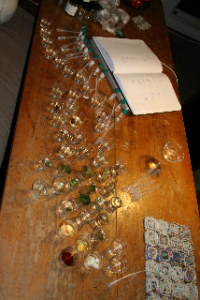 Internettraces : Raewyn Turner & Mary Griffiths
Internettraces : Raewyn Turner & Mary Griffiths
4000 Varieties of Orange is in collaboration with Brian Harris who works in robotics and engineering, explores secondary (the smell of place, food we eat) + tertiary (playground of perfumes and deodorants), human smell.
We’ve designed a food tasting event to be held New Plymouth at Eco Sapiens and its theme will have a focus on food monocultures and fragrance/flavour biodiversity.
Our intention is to create delicious foods using a limited palette of four staple foods and a large palette of food flavourings.
At SCANZ Ecosapiens headquarters we set up a kitchen and have begun to create flavoured pies.
We’ll make pies from the 4 staple foods and flavour them with nature-identical flavours.
Formula Foods is generously providing flavours for the project.( Thanks Formula Foods!) Formula Foods
The recipes and flavours will be drawn from the recipes from Mrs Beeton’s Everyday Cookery and Housekeeping book ( around the turn of last century).
An example from Mrs Beeton’s book : November : ‘Things in Season’
Fish: brill, cod, crabs, eels, haddocks, oysters, pike, soles, turbot, whiting
Meat: Beef, mutton, veal, doe venison
Poultry: Chickens, fowl, geese, lark, pidgeons, pullets, rabbits, teal, turkeys, widgeon, wild duck
Game: Hares, partridges, pheasants, snipe, woodcock
Vegetables: Beetroot, cabbages, lettuces, late cucumbers, onions, potatoes, salading, spinach, sprouts-various herbs,
Fruit: Apples, bullaces, chestnuts, filberts, grapes, pears, walnuts
We researched historic food ingredients and presentation, focusing on the creation of hand raised pies and sprung metal pie moulds.. During the seventeenth and eighteenth centuries, pies were made in very elaborate shapes. Ivan Day’s Historic Food.
Months before EcoSapiens we started experimenting in Auckland. We wanted to get the flavouring to work and develop pastry recipes to create pie sculpture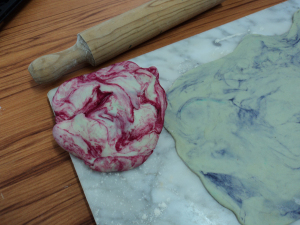
eg
Hot water pastry for hand – raised pies:
4 cups flour
1 cup suet or shreddo
hot water to mix
pinch salt
Below: Our first pie creation in celadon green with gold leaf detail, was filled with shaped tofu pieces fired with organic red onions and garlic. The filling was flavoured with drops of beef, chicken and bacon flavourings. The lid was hand modelled.
We found a wild apple tree on
the side of the road between
Waitaanga and Ohura.
It was laden with fruit which
provided us with apples for
Flavouring the pies was a challenge due to the complexities of combining texture, fragrance, flavour and visual attraction. We sought advice from award-winning chefs on recipes to create tasty pie fillings which we then adapted for the project( using soy instead of meat.)
An example of one of the pies was where we’d used chicken, beef and bacon flavourings to substitute for bird flesh. The filling was mock chicken—a type of soy protein.
When the pie was opened we noticed a definite shift from the visual pleasure of the pie to olfcto/gustatory displeasure.
We decided to utilize readily available food that would give a more pleasant taste experience – the sort of food that is readymade and available in supermarkets and already had a positive hedonic value, eg sponge cake made with wheat flour.
Our tastes are changing and adapting due to a vast diversity in fragrances and flavours being added to food. New associations are being made. Similarly our sense of colour is changing as we become accustomed to the concept of ‘millions of colours’, and the colour spectrum of coloured light—red, blue and green, on computer screens.
4000 Varieties of Orange ( in progress): Each piece of cake is individually flavoured.
We’ve started tasting authentic flavours alongside synthetic flavourings. We found that the synthetic flavourings are more real than the real flavour—they’re molecular constructions that convey the IDEA of flavour, thereby creating illusions.
The table centrepiece :A further experiment in progress is an ‘apparatus’ intended as an interactive flavour dispensing table display stand–photos coming soon.
‘Nothing is allowed an odour of its own, even food
The deodorising of things…to smell like ‘ nothing’
…smells of the denial of imagination’
( Bamford, Christopher, Green Hermeticism 2007
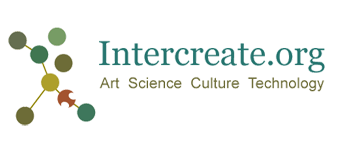
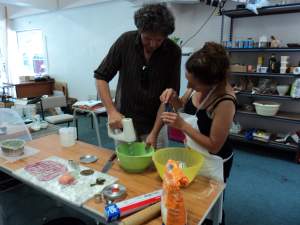
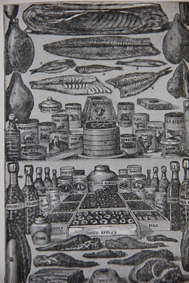

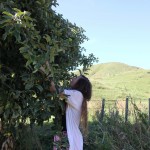
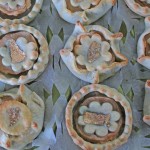
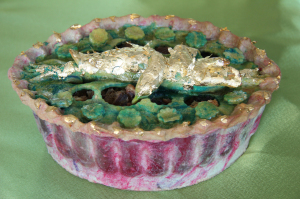

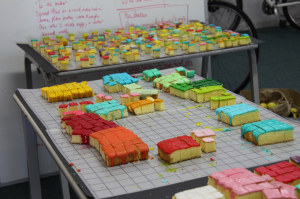
Hi Diane–Hi how are you? was just putting this on my blog and happened upon your comment–please tel me about your work with Andrea and dandelions!! ? look forward to it–hey we used to pick dandelion leaves from the front lawn to add to salads …..
Raewyn it is so exciting to see these developments from early discussions to the full realisations, so vibrant with colour-not surprising from you, but somehow rendering resonant equivalences to the scents and flavours.
Have you done any work with dandelions by any chance? Andrea and I are working in that arena.